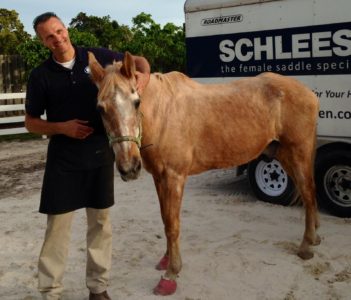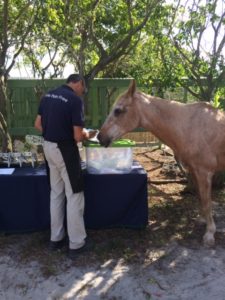Saddle Fit and “the Old Folks”

I absolutely love the idea that the Dressage Foundation www.dressagefoundation.org has, of celebrating their “Century Club” – riders and their horses who together are at least 100 years old. It is always so wonderful to see these beautiful animals who are so well loved that their owners allow them to live out their lives in peace and in a natural setting in the country. Living with their friends in a herd setting, and enjoying their last years in comfort.
I’d like to introduce you to my oldest equine friend. He was a 48 year old (as confirmed by the vet!) thoroughbred X, living in FLA and no longer ridden, although he was active until just a few years ago. His name was Lucky (which he truly was!) and in human years he was apparently the equivalent of 96 years old (based on the calculation that apparently one horse year = 2 human years). I was gratified to see that his owner’s diligence in always using a properly fitting saddle on him paid off with regards to protecting him against long term back damage, lameness, and other physiological problems but unfortunately he passed away just his week L – died peacefully in his sleep. He always used to watch me when I adjusted the saddles for our clients at his barn. He ran free all around the farm and made sure everything was in order. He did the due diligence for the other members of his herd and watched that I didn’t make any mistakes. This horse seemed to approve when we fitted saddles, which brings tears to my eyes.
I find horses very spiritual beings; very intuitive – and they seem to know when you are there to help them. I have dealt with many horses whose owners tell me they’re vicious, dangerous, bite, kick, etc. – but they are almost always gentle when I approach them. (knock on wood – I have been very lucky thus far in my career!!)
Our oldest human rider was a lady we have featured on our YouTube channel – Elsa was a firecracker of 93 years old (watch her video – unfortunately this lovely woman also passed away – a couple of years ago – but she went with a smile, knowing she had spent her last years doing what she loved!)
This blog is my tribute to them as my oldest ever clients.
Going back to Nature?

The current trend in riding, as in most other things, seems to be “going back to nature”. Riders everywhere are interested in current discussions about whether or not to shoe, whether or not to ride bareback, whether or not to “chemically” supplement your horse’s diet. According to documented statistics, the following life expectancies show the opposite to be true:
- Life expectancy of the wild horse (for example Mustang) is 5-7 years.
- Life expectancy of a horse ridden by an inexperienced rider, never exercised to the point of cardiovascular exertion: 7-10 years.
- Life expectancy of a horse under professional training and supervision, ridden in competitive sports or in active training: 20-25 years.
- Life expectancy of a horse whose rider ensures a healthy lifestyle (which includes using a properly fitting saddle to protect against long term back damage and ensure many years of riding pleasure): 25+ years – of which above is a really good example!
Doesn’t that tell you something?? Nature may be good; professional advice and proper equipment to do “what’s right” could prove to be better for your horse.
The whole “circle of influence” philosophy should be considered when determining what is best for your horse. The complementary efforts of professionals such as your veterinarian, farrier, chiropractor, and saddler, will exert their influences positively, to enable you and your horse to achieve maximum life expectancy, health and performance.
What does a professional look for and consider when called in to address a problem or concern? Clearly, there are many external factors and influences acting upon a horse at any given time. For example, consider that there are 15 points which can influence saddle fit (or saddle fit perception) alone:
Rider |
Saddle |
Horse |
|---|---|---|
| Ability improves | Flocking shifts | Training / Conditioning |
| Changing disciplines | Leather condition | Age |
| New trainer with different expectations |
Tree twisting (due to uneven musculature of horse and/or rider |
Nutritional changes |
| New horse | Billets stretching | Health swings |
| Weight loss/gain | Seat foam settles | Re-shoeing |
In summary, it doesn’t matter what you choose to ride in or wear, the key principle is to be aware that everything needs to work together properly. No matter how well a saddle fits at the time of purchase, one saddle will not fit a horse over the course of its life (unless the saddle can be adjusted and re-fit). Every horse goes through at least 7 major conformational changes as it matures. Keep in mind that not every saddle on the market is adjustable, nor can be easily adjusted.
I commit to keeping up with latest research, industry knowledge and technology, in our products and in our services. I confer on a regular basis with other equine professionals. My staff of certified saddle fit technicians and saddle ergonomists commits to educate riders to make intelligent and informed decisions. We ensure that your saddle will fit you and be totally comfortable for you and your horse, improving your ability to ride and your horse’s capacity to perform. Work with a knowledgeable fitter you can trust and who knows the interaction between biomechanics, anatomy and physiology!
